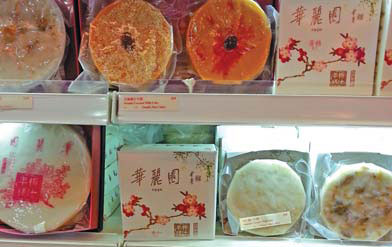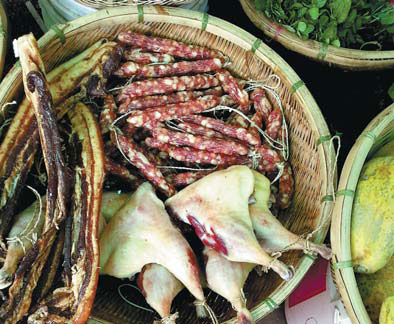Southern traditions still going strong
Updated: 2014-01-26 07:21
By Wang Yuke in Hong Kong(China Daily)
|
|||||||
While the rest of China scrambles online to buy festive delicacies, shopping on Hong Kong's streets remains very much the norm, and online purchases aren't as common.
The reason is simple. Hong Kong has always had the best from both the southern and northern hemispheres.
And Hong Kong's consumer culture is so sophisticated that even in the satellite towns in the New Territories, local markets are brimming with a colorful assortment of Lunar New Year essentials.
Hong Kong also takes seriously its reputation as a gourmet city and believes the best food for the reunion dinners is still made locally. And for good reason.
The festive atmosphere is apparent everywhere, and the local markets are where anticipation and exuberance peak.
Grocery stalls are placing a cornucopia of nuts and sweets on prominent display. They're offering traditional groundnuts, melon seeds, pumpkin seeds and imported almonds, hazelnuts, pistachios and macadamias, just to name a few. Customers stop to admire and taste before making their final selections.
Candied confections are also popular here. Candied coconut wedges, lotus root slices, winter melon strips and pearls of candied lotus nuts are frosted with sugar, while whole candied kumquats add a splash of color among the white.
Ubiquitous is the fiery red hue deemed most auspicious for the New Year. Poetic couplets printed on red paper or red velvet declare rhymed blessings upon the nation and family, and strings of vibrant red lanterns and all sorts of festive ornaments wait to be taken home. This year, the Year of the Horse, sees plenty of stuffed red ponies on display.
The reunion dinner on the eve of the Lunar New Year is especially important in Hong Kong. Most families spend New Year's Eve and the first two days of the festival at home, chatting, bonding and eating - and then eating some more.
Guests coming to visit are offered a carousel platter stuffed with sweets, snacks, melon seeds, peanuts and other delectable tidbits. Mandarin oranges are exchanged as gifts - their bright orange color is symbolic of the gold to be earned in the coming year.
Special New Year dishes include niangao, the glutinous rice cakes eaten during this period, and pencai, a one-pot dish layered with chicken, prawns, meatballs, duck, bean curd puffs and radishes.
Another highly regarded must-have are the sweet preserved meats of sausages made of pork and duck liver, salty pressed duck legs and cured belly pork. These lawei, or cured meats, must be eaten during the reunion dinner on the Eve and are often served steamed and garnished with slices of arrowroot bulbs.
Whole stalls at the markets will sell these seasonal selections of cured meats, often adding legs of Chinese ham from Xuanwei in Yunnan or Jinhua in Zhejiang.
As well as in the market and street stalls, almost every Chinese restaurant in Hong Kong pushes their own special flavors of niangao, that savory rice cake that is such a good standby for the unexpected guest who drops in.
Typical rice cakes are round - the perfect circle alluding to the well-being people crave and pray for. They are normally sweet and traditionally flavored with brown sugar, honey, coconut milk, osmanthus flowers and Chinese dates. These days, however, competition among restaurants has driven creativity to exceptional heights, and many new flavors or combinations of flavors appear every year.
There are also savory cakes made from rice flour and loaded with radishes, yams or pumpkins and dotted with cubes of cured meats, dried shrimps and ham. These were traditionally made at home, but hectic urban lifestyles mean many families now buy them readymade.
Pencai, the one-pot dish, is a relatively new trend that originated in the old walled Hakka villages deep in the New Territories.
Nowadays, restaurants offer it through the 15-day New Year period, and there are even vacuum-sealed packages that you can take home and heat up.
Perhaps nowhere is the phenomenon in which ancient meals meet modern packaging - in the literal and metaphorical senses - clearer than in Hong Kong.
sundayed@chinadaily.com.cn
|
Niangao, or festive glutinous rice cakes, highlight tables during Spring Festival. Photos by Wang Yuke / for China Daily |
|
Lawei, or cured meats, are eaten during the reunion dinner on Lunar New Year's Eve. |
(China Daily 01/26/2014 page3)

